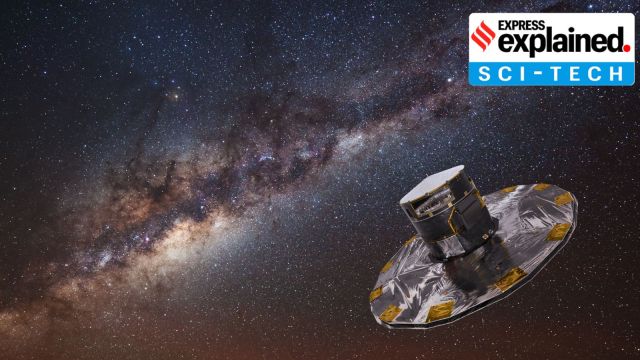The European Space Agency (ESA) shut down its space observatory mission, Gaia on Thursday (March 27). Launched into space over a decade ago, Gaia has been instrumental in charting the Milky Way galaxy, revealing its past and estimating its future.
Gaia was launched in December 2013 aiming to create the most precise, three-dimensional map of the galaxy. It began taking observations on July 24, 2014, finally shutting its eyes on January 15, 2025. Over the last decade, Gaia has taken 3 trillion observations of 2 billion stars and objects and helped inform at least 13,000 scientific publications.

What exactly is the Gaia mission?
Originally named Global Astrometric Interferometer for Astrophysics (GAIA), the mission was renamed Gaia. Gaia was designed for astrometry, the science of mapping the cosmos, through precise measurement of the location and movement of stars and other celestial bodies.
Gaia was positioned in the Lagrange point 2 (L2), around 1.5 million kilometres ‘behind’ the Earth, when viewed from the Sun. This effectively allows the spacecraft to view the larger cosmos unhindered by the planet, the Sun and the Moon.
 A diagram of the L2 position (Credits: ESA)
A diagram of the L2 position (Credits: ESA)
As it twirls in space, twin telescopes, placed in different directions, direct light onto a single digital camera with nearly a billion pixels, making it the largest flown in space. The spacecraft is fitted with three instruments – an astrometer, a photometer and a spectrometer – that help interpret the location and motion of stars and other objects.
Through Gaia’s eyes
Gaia has transformed the way the Milky Way galaxy is viewed. Its data allowed scientists to recreate not just a 3-D map of the galaxy, but also how it will change over time.
Scientists were able to understand the shape of our galaxy, which has a central bar and spiral arms. Viewed from its edge, the galaxy is seen as a disc with a bulge at the centre. However, Gaia shows that this disc is warped and wobbles – that is, it rocks left to right (very, very slowly). This is likely caused by collisions with a smaller satellite galaxy.
Story continues below this ad
According to Professor Chris Lintott, a British astrophysicist and professor at the University of Oxford, the ripples produced by these collisions still exist and may have resulted in the formation of stars, including the Sun. “This shows how Gaia is revealing that the Milky Way’s history is both more dynamic and more complex than we thought,” he stated in a lecture at Gresham College on February 26.
While mapping the skies, Gaia has also uncovered a new kind of black hole – including one close to the Earth. While black holes were previously discovered by light emitted by materials falling in, those discovered by Gaia are “truly black and can only be detected by their gravitational effects,” according to the ESA. It has also detected over 1,50,000 asteroids and projected their orbits, including those that may pose a threat to the Earth in the future.
Gaia’s retirement plans
After the mission shuts its space eyes, scientists have been conducting tests to assess the behaviour of technologies after spending 10 years in space, and help build future missions.
On Thursday, the official X account of ESA Gaia announced that the spacecraft had been “successfully passivated”, meaning it had been drained of any internal energy sources and will not reboot again. Shortly before, Gaia used its thrusters for the final time to slowly drift into its “retirement orbit” around the Sun.
Gaia’s legacy lives on
A bulk of Gaia’s data is yet to be processed. Scientists at the ESA have been actively downlinking all the data collected by the spacecraft over the years, which will be released in the coming years, leading to more discoveries.
Story continues below this ad
The ESA has said that a part of the remaining data will be released next year, which will cover the mission’s first five-and-a-half years. Another set of data will be released at the end of this decade.
Despite its scope and magnitude, Gaia would have mapped just about 2% of the 100 billion stars in the galaxy, leaving much to be explored.



 A diagram of the L2 position (Credits: ESA)
A diagram of the L2 position (Credits: ESA)




































